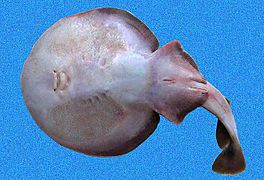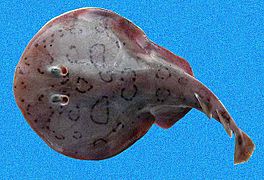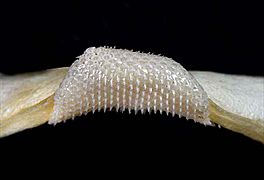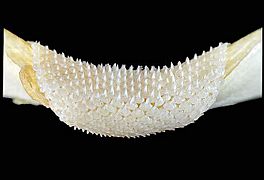Lesser electric ray facts for kids
Quick facts for kids Lesser electric ray |
|
|---|---|
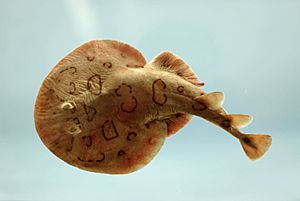 |
|
| Conservation status | |
| Scientific classification | |
| Kingdom: | |
| Phylum: | |
| Class: | |
| Order: | |
| Family: |
Narcinidae
|
| Genus: |
Narcine
|
| Species: |
N. bancroftii
|
| Binomial name | |
| Narcine bancroftii (E. Griffith & C. H. Smith, 1834)
|
|
 |
|
The lesser electric ray (Narcine bancroftii) is also known by many other names, like the Brazilian electric ray or small electric ray. It's a type of numbfish found along the western coasts of the Atlantic Ocean and in the Caribbean Sea. This small, slow-moving fish lives in sandy or muddy areas near the shore. It can sometimes be caught by accident when people are fishing for shrimp or using large nets. The International Union for Conservation of Nature says it is of "least concern", meaning it's not currently in danger of disappearing.
Contents
What it Looks Like
This ray has a body that's almost round and a short tail. It can grow to about 45 centimeters (18 inches) long and 20 centimeters (8 inches) wide. Its color can be dark brown or reddish-orange. It often has irregular rings, sometimes shaped like ovals, on its back. Its underside is usually white or greenish. It has many rows of teeth, from 17 to 34 in each jaw, depending on how big the ray is.
The lesser electric ray has two special electric organs. These long organs run from just in front of its eyes to the back of its body. They can create an electric shock of about 14 to 37 volts. The ray uses this shock to surprise its prey and to protect itself from danger.
Where it Lives
You can find this ray in the Gulf of Mexico and in the coastal waters of the western Atlantic Ocean. Its range stretches from northeastern Brazil all the way up to North Carolina in the United States. It also lives in the Caribbean Sea and the West Indies.
Its Home
The lesser electric ray usually lives hidden under sand or mud in shallow waters near the shore. However, it has also been found in deeper waters, up to about 55 meters (180 feet) deep.
How it Behaves
This ray is active at night. During the day, it stays still, often buried in the sand. At night, it comes out to search for food in the sand or mud. It's not a fast swimmer and tends to stay in its own small area near the beach.
Reproduction
Female lesser electric rays become ready to have babies when they are about two years old. They can give birth to as many as twenty live young at one time.
What it Eats
Lesser electric rays mostly eat small worms called polychaetes. They also enjoy eating young snake eels, sea anemones, small fish, and different kinds of crustaceans like crabs and shrimp.
Its Status
The lesser electric ray is often caught by accident when people are fishing for shrimp or using large nets near the coast. In some areas, like the Gulf of Mexico, its numbers have dropped a lot since the 1970s.
However, experts have looked closely at the ray's population more recently. They used different types of information and found that the population is not currently in danger of disappearing. Because of this, the International Union for Conservation of Nature has listed the lesser electric ray as being of "least concern". This means it's not considered an endangered species right now.
See also
 In Spanish: Raya eléctrica para niños
In Spanish: Raya eléctrica para niños



